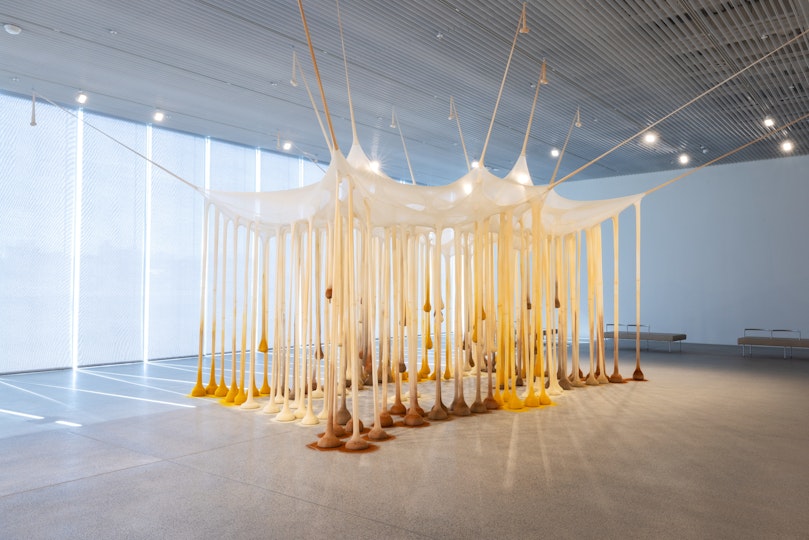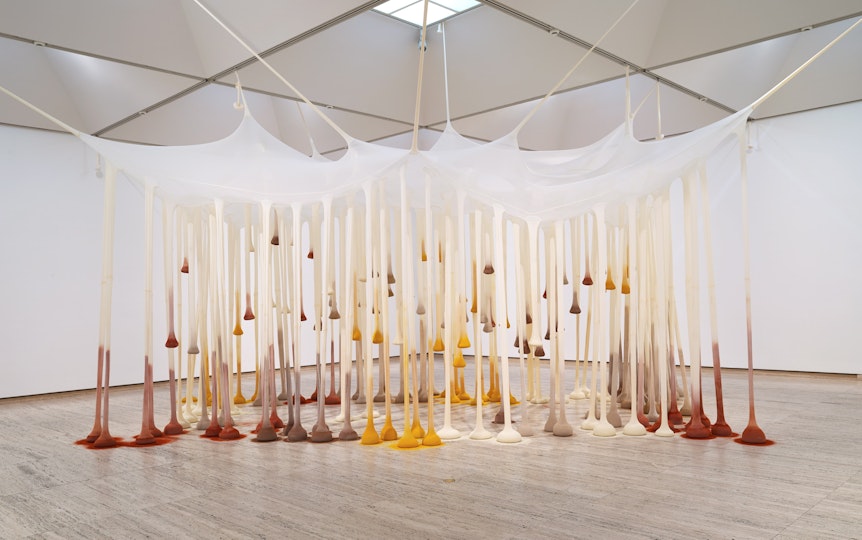Ernesto Neto

Ernesto Neto Just like drops in time, nothing 2002, Art Gallery of New South Wales © Ernesto Neto

Ernesto Neto Just like drops in time, nothing 2002, Art Gallery of New South Wales © Ernesto Neto
One day, I was enticed by the smell of this spice shop, and I bought some turmeric for my studio. After some time, I became dizzy from the smell of just turmeric, so I went back to the shop and I got other spices – it kind of balanced the environment. It’s not an intellectual decision, you are captured, captivated, swallowed by the energies, which then sprout through the art.
Just like drops in time, nothing 2002
This artwork by Brazilian artist Ernesto Neto (born 1964) is often smelt before it is seen. Within a translucent membrane, described by one writer as ‘industrial-strength pantyhose’, the artist has contained vast quantities of spices selected for distinctive colours and aromas. Variously suspended in the air or resting gently on the floor, each ‘drop’ contains either pepper, turmeric, cumin, paprika, cloves or fenugreek.
Neto has given careful consideration to sculptural principles of volume, tension and gravity in composing the artwork’s amorphous and delicately balanced shape. He was also influenced by a generation of Brazilian artists who pioneered interactive and sensory forms of art throughout the 1970s. He invites visitors to move around his sculpture, to notice its colours, forms and textures, and to inhale its heady scents.
-
K–6 discussion questions
Look closely at the installation Just like drops in time, nothing 2002. What shapes and colours do you see? What do these forms remind you of? Does the title of the artwork give you clues as to what these shapes might reference? Look at how the artwork connects and relates to the ceiling, floor and space around it. How do you think the space affects the shape it takes?
Neto often uses herbs and spices in his art. In this work, he has filled each ‘drop’ with either pepper, turmeric, cumin, paprika, cloves or fenugreek. These spices are often used in Indian cooking and have very strong and distinct scents. Looking at the colours in this work, can you guess which spice is which? What do you think it smells like being in the same room as this artwork? Can a smell alone be an artwork?
Neto is interested in the sensory experience of being in a place, using all one’s senses – including smell. Close your eyes and take a big breath in through your nose. Identify and write down all the things you smell – nearby pencils or markers, cleaning supplies used in the classroom, or someone’s lunchbox, for example. Swap your list with a classmate. Are they similar or different? Discuss how these smells might describe the place you’re in.
-
K–6 activities
Just like drops in time, nothing is made with polymer stretch fabric, which is similar to the material used to make stockings or tights. For Neto, this material is like skin or a membrane. Collect old pairs of stockings and make a sculpture of your own. Experiment by filling the stockings with different materials, such as sand, found objects or soft materials. What do you notice about the shapes made by these different materials? How do the objects or materials you’ve used take on a new life? Write a short story inspired by these new forms to accompany your sculpture.
What is your favourite smell? What is your least favourite smell? If you were to create an artwork that captured each of these smells, what would it look like? Using scrap pieces of coloured paper, make a collage that evokes your favourite smell and one that captures your least favourite. Think about which colours and shapes you’ve used to evoke these smells and why.
-
7–12 discussion questions
In an interview in 2018, Neto said: ‘Gravity is a very intimate force. To me gravity is probably the closest expression of God – a spiritual power, a vital energy that holds everything together. It can hinder us, but it can also comfort us. Gravity reminds us of our existence by letting us sense the weight of our own body.’ Consider this quote in relation to Just like drops in time, nothing. Can you pinpoint instances of gravitational forces at play in this work? In what ways is this work ‘intimate’? How does it make us think about our own bodies?
Compare Just like drops in time, nothing to two artworks in the Art Gallery’s collection that are also made with herbs and spices: Perfumed paintings and stools 1995–97 by Montien Boonma (1953–2000) and Spice window 1971 by Dieter Roth (1930–98). Describe how each artist uses these organic materials both technically and conceptually. As a result, what is the impact on the viewer in each of these works?
Neto was influenced by a generation of Brazilian artists who pioneered interactive and sensory forms of art throughout the 1970s. Research the practices of some of these artists, such as Hélio Oiticica and Lygia Clark. How do the ways these artists considered the viewer compare to Neto’s? Consider the artistic, social and political climate of the time. How do you think time and place affect the way an interactive or sensory work is experienced and interpreted?
Read about the installation of Neto’s artwork. Reflect on museum practice and the considerations required to care for, display and interpret this artwork now and into the future. Like Neto, if an artist’s intent is for the artwork to change with time to reflect a sense of impermanence and fragility, then what are the responsibilities of the museum?
-
7–12 activities
Neto is interested in the immersive experience of art. Compare Just like drops in time, nothing to another work by the artist in the collection called Sonambulinos 1999. How are these artworks immersive? What kind of participation is required of the viewer? As a class, reflect on these artworks to create your own immersive installation. Think about the sensory experience of your audience. Will it include tactile, olfactory or auditory components? Examine the space you’re in and think about how your work responds to it and to the bodies moving through it. Invite another class to experience your work, and record their responses. Are they what you imagined or intended?
Neto has said that in creating his work, he ‘wraps air’. Think about this concept in relation to Just like drops in time, nothing. How does Neto conceptualise air, or give it form? Think about what ‘wrapping the air’ might mean or look like to you and create an artwork to reflect your ideas.
Just like drops in time, nothing is a forerunner to Neto’s large-scale installations and experimentations with polymer stretch fabric, or nylon. Nylon is a permeable and semi-transparent material, but also stretchy and flexible. Experiment with materials to make your own stretchy sculpture. Research and collect a variety of materials that can stretch, twist and bend, like elastics, nylon, slinkies, spandex, rubber gloves or even string cheese. Like Neto, play with gravity and the idea of suspension to highlight the qualities of your chosen material.